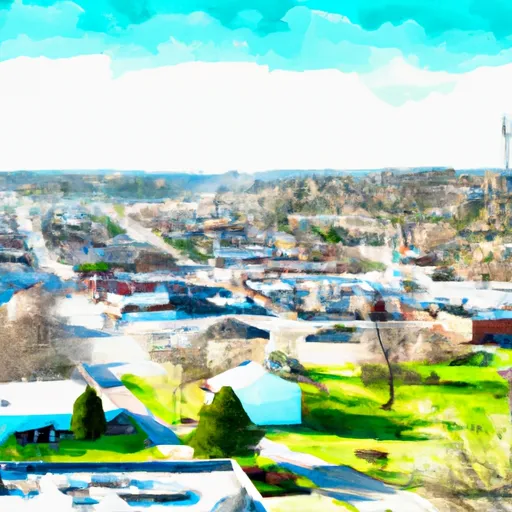-
 Snoflo Premium
Snoflo Premium
Get unlimited access to all our content
With no Ad interruptions! - Start Your Free Trial Login with existing account
Rush
Eden Index
Climate
8.3
•
Recreation
1.7
•
Community
1.7
•
Safeguard
4.3/10

Rush, Kentucky is a small town located in Boyd County, in the northeastern part of the state. The climate in Rush is classified as humid subtropical, characterized by hot, humid summers and mild, yet occasionally cold winters. The average high temperature in the summer months ranges from 85°F to 90°F, while winter temperatures average around 40°F.
Hydrologically, Rush is situated near the Ohio River, which forms the northern border of the town. The river influences the local hydrology, offering opportunities for water-based activities such as boating, fishing, and kayaking. The Ohio River also serves as a vital waterway for transportation and commerce.
Outdoor recreation enthusiasts in Rush can explore the nearby Yatesville Lake State Park, which is located about 10 miles southeast of the town. The park offers a variety of outdoor activities, including hiking, camping, picnicking, and boating. Fishing is particularly popular at the lake, which is home to various species such as bass, catfish, and crappie.
Overall, Rush, Kentucky provides a pleasant climate, access to the Ohio River, and proximity to Yatesville Lake State Park, making it a destination for outdoor enthusiasts seeking recreational opportunities in a small-town setting.
What is the Eden Index?
The Snoflo Eden Index serves as a comprehensive rating system for regions, evaluating their desirability through a holistic assessment of climate health, outdoor recreation opportunities, and natural disaster risk, acknowledging the profound impact of these factors on livability and well-being.
Climate Health Indicator (CHI): 8.3
Rush receives approximately
1113mm of rain per year,
with humidity levels near 83%
and air temperatures averaging around
12°C.
Rush has a plant hardyness factor of
6, meaning
plants and agriculture in this region thrive during a short period during spring and early summer. Most
plants will die off during the colder winter months.
By considering the ideal temperature range, reliable water supplies, clean air, and stable seasonal rain or snowpacks, the Climate Health Indicator (CHI) underscores the significance of a healthy climate as the foundation for quality living.
A healthy climate is paramount for ensuring a high quality of life and livability in a region, fostering both physical well-being and environmental harmony. This can be characterized by ideal temperatures, reliable access to water supplies, clean air, and consistent seasonal rain or snowpacks.
Weather Forecast
Streamflow Conditions
Middle Ohio-Raccoon
Area Rivers
Middle Ohio-Raccoon
Snowpack Depths
Middle Ohio-Raccoon
Reservoir Storage Capacity
Middle Ohio-Raccoon
Groundwater Levels
Recreational Opportunity Index (ROI): 1.7
The Recreational Opportunity Index (ROI) recognizes the value of outdoor recreational options, such as parks, hiking trails, camping sites, and fishing spots, while acknowledging that climate plays a pivotal role in ensuring the comfort and consistency of these experiences.
Access to outdoor recreational opportunities, encompassing activities such as parks, hiking, camping, and fishing, is crucial for overall well-being, and the climate plays a pivotal role in enabling and enhancing these experiences, ensuring that individuals can engage in nature-based activities comfortably and consistently.
Camping Areas
| Campground | Campsites | Reservations | Toilets | Showers | Elevation |
|---|---|---|---|---|---|
| German Bridge - Dewey Lake | 40 | 653 ft | |||
| Littcarr - Carr Creek Lake | None | 1,050 ft | |||
| Paintsville Lake State Park | 40 | 618 ft | |||
| Flag Rock Recreation Area | 21 | 2,461 ft | |||
| Portal 31 RV Park | 20 | 1,841 ft | |||
| Natural Tunnel State Park | None | 1,703 ft | |||
| Cane Patch | 34 | 1,672 ft | |||
| High Knob | 77 | 3,608 ft | |||
| Jenny Wiley State Park | 115 | 857 ft |
Nearby Ski Areas
Catastrophe Safeguard Index (CSI):
The Catastrophe Safeguard Index (CSI) recognizes that natural disaster risk, encompassing floods, fires, hurricanes, and tornadoes, can drastically affect safety and the overall appeal of an area.
The level of natural disaster risk in a region significantly affects safety and the overall livability, with climate change amplifying these risks by potentially increasing the frequency and intensity of events like floods, fires, hurricanes, and tornadoes, thereby posing substantial challenges to community resilience and well-being.
Community Resilience Indicator (CRI): 1.7
The Community Resilience Indicator (CRI) recognizes that education, healthcare, and socioeconomics are crucial to the well-being of a region. The CRI acknowledges the profound impact of these elements on residents' overall quality of life. By evaluating educational resources, healthcare accessibility, and economic inclusivity, the index captures the essential aspects that contribute to a thriving community, fostering resident satisfaction, equity, and social cohesion.

